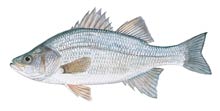Freshwater Fish - Species
Species Specific Regulations
White perch
Freshwater Fishing License required.
Complete fishing regulations
White perch (Morone americana) - Native
Description: (Anatomy of a Fish)
White perch are silver-green to olive in color. The underside of their lower jaw is often purple. The spiny and soft dorsal fins are joined by a membrane. The anal fin contains three spines; the second spine is thicker than the first and almost as long as the third. There are no teeth on the tongue of the white perch.
Range: All reservoirs except Keowee and Jocassee
Average Length: 6-9 inches
Average Size: Less than 1 pound, most landlocked specimens less than 1/3 pound
South Carolina State Record: 1-15.2 pounds (2007)
Life Expectancy: Approximately 17 years
Preferred Habitat
White perch were primarily found in estuarine and marine habitats throughout the Atlantic coast southward to areas near Charleston, SC. It is now common that they also inhabit the Piedmont in the Pee Dee, Santee, Cooper, Broad, Saluda and Savannah rivers and many of the inland reservoirs such as lakes Murray, Greenwood, Thurmond and Wateree.
Food Habits
- They have a diverse diet including worms, shrimp, crabs, insects and small fishes.
Spawning
- White perch are a schooling species that are semi-anadromous, meaning they move between estuarine and fresh waters to spawn.
- From April to June, when water temperatures average 50-60°F, white perch migrate from estuarine waters into large rivers where females release up to 150,000 adhesive eggs.
- Populations that are locked within reservoirs do not follow this pattern, but instead migrate within the reservoir.
- Immediately following the laying of the eggs, males release millions of sperm cells. In spite of this haphazard spawning ritual, the ratio of hatched eggs is enormous when compared to other fish.
- Eggs can hatch in as little as 30 hours or take as long as six days depending on water temperature.
Miscellaneous
Fisheries biologists are concerned about white perch because its prolific reproductive capabilities give it a competitive advantage over some more desirable species. Although scorned by some fishermen as a pest (small size), the white flaky flesh of the white perch is among the best.
Commonly Mistaken Species
Some species of fish that are commonly mistaken for this species:
Literature Cited
Rohde, Fred C, Arndt, Rudolf G., Foltz, Jeffery W., Quattro, Joseph M. 2009. Freshwater Fishes of South Carolina. University of South Carolina Press, Columbia, South Carolina.
Wildlife and Freshwater Fisheries Division. 2009. South Carolina Guide to Freshwater Fishes.
Fish Illustration by Duane Raver.


